18 October 2022 / 3-Min Read / Translate
I learnt this drill many years ago when I was working as Jonah Barrington’s “warm up” man. Basically, when Jonah had a training/coaching session with a pro, if I was around, I would hit with the pro for 30 minutes before they moved onto Jonah. This was too ensure they were fully ready to work with Jonah – no wasted time.
One time, Paul Johnson came, yes the Paul Johnson from Squash TV, and I asked him what he wanted to do. I did this because I had found that most pros had their own routine they preferred to do and I certainly wasn’t going to impose my ideas on them. He said he wanted to just hit crosscourts. Okay, I thought, no problem, can’t be too hard. I was wrong.
For the next 30 minutes, swapping sides every 5 minutes, he pummelled me into the corners with hard and low crosscourt drives. Really, that’s all we did. No volleys. No boasts. No kills. No lobs. Absolutely nothing else. Just those mother-freaking crosscourts.

The suit and smile masks the ruthlessness inside Paul Johnson!
From that moment on, I became addicted to that drill. I wanted to master it. I wanted to be able to do to other people what Paul had done to me. I never did, but it was/is fun trying. So let’s look at exactly why such a simple drill is so effective and also at some variations that can keep it interesting for obsessed players.
Both players stand in a back corner and hit. Crosscourt shots to each other. That’s it. Simple, right? Do it non-stop for 5 full minutes and it gets harder. Not because of any physical aspect, but because you realise how inconsistent your crosscourts are. They are probably all over the place. When you only do 10 or so shots then you don’t really pay attention to that inconsistency, but when you do nearly 250 shots in 5 minutes, you do.
Start by standing a little further back than you would for a service return. You do this because you want to avoid volleys if you can. If you can make you shot hit the side wall past the service box and quite low, you will make it really difficult for your opponent to hit a good crosscourt return.
Pay attention to the front wall too. You won’t be able to hit every shot at the same place, because your point of contact will be different each time, and this is one of the key benefits of this drill. It teaches you to make adjustments, but still get the same result.
No, I don’t expect anything from you. However, I do hope that you will try to do 12 minutes once a month. Ideally, twice a month, but I understand that club players want to “lay” squash, not train all the time, so find a schedule that fits your ambitions. Those 12 minuets are 3 sets on the forehand and 3 sets on the backhand, swapping every 2 minutes.

This photo is from a real rally, but the player’s position in the back is similar to what you should be aiming for in this drill, especially if you play the alternate straight drive.
Try scoring it. Scores often focus your mind. Force your opponent to hit a shot that doesn’t land in your back quarter or hits the side wall before the short line and you win a point. Play 3 points each side before you swap sides.
Next, hit a straight drive off your opponents’ crosscourt, then hit you crosscourt. This can both simplify the drill or complicate it, depending you your skill level and how ell you hit straight drives off crosscourts.
Another variation, is to aim to hit your crosscourt not at the side wall, but to bounce on the floor and then hit the back wall and finally go near the side wall. It’s a nice variation to develop a rhythm and for many players is a little easier. You can include the alternate straight drive in this variation too.
In case it’s not clear, no volleys are allowed, at least for the first few sessions. This will make you hate me and the drill, but it teaches you to move backwards to give yourself space. Eventually, feel free to volley, but better to avoid it for this drill.

Notice how carefully he is watching the ball.
Hit the ball firm but not as hard as you can. The more power you try to add, the less accurate your shots. Also, as I have already mentioned focus on the front wall and make minor adjustments based on exactly where you are hitting the ball from. The straight drive really can make this easier, unless your opponent is hitting fantastic crosscourts, in which case hitting a good straight drive becomes even harder.
Beginners can do this with each other, but should stand a little further forward and aim to hit as many shots without mistakes as possible. The better you get, the less cooperation between the two players should occur.
If you take this drill seriously, it will seriously improve your game. if you approach it as a quick warm up drill instead of a proper drill in its own right, then you won’t get much benefit. The scoring variation really focuses your mind, but only do it if you have reach a good club level. hard and smart squash training doesn’t have to use the trendy ideas, sometimes the most basic workouts are the most effective.